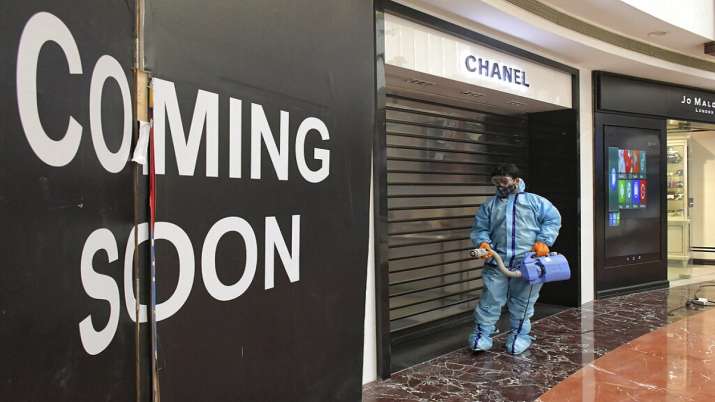[ad_1]

A man sanitizes the premises of a shopping mall before reopening after being closed since April as part of measures to curb the spread of coronavirus in New Delhi.
From creating a ’24-hour city’ with night-time economy, extensive transport infrastructure, affordable housing for all and healthy environment to checking unauthorised colonies and pollution – these are part of the guiding principles the DDA has laid out for the ‘Master Plan of Delhi 2041’.
The draft of MPD-2041, which was put in the public domain on Wednesday for suggestions and objections, largely covers the policies of environment, economy, mobility, heritage, culture and public spaces among others.
Master Plan of Delhi 2041 | Insights
- The plan calls for affordable rental housing and residential areas with complete facilities and small format housing in the national capital over the next 20 years.
- It also proposes that there should not be further growth of unauthorised colonies, adding that there should be development of urban villages within two years of the notification of the MPD 2041.
- According to the draft plan by the Delhi Development Authority (DDA), Delhi’s population is estimated to go up to 3.9 crores against the 1.67 crores in the 2011 Census.
- Given the rising concerns regarding pollution, a shift towards cleaner economies such as information technology (IT), IT-enabled services, knowledge-based and hi-tech industries, entrepreneurial activities, realty market, tourism, hospitality, tertiary healthcare and higher education is envisaged, stated the voluminous draft.
- The concept of a ’24-hour city’ is being promoted through the Model Shops and Establishments (Regulation of Employment and Conditions of Service) Act, 2015 as well as the night-time economy (NTE) policy, it said.
- The night-time economy is gaining prominence in many countries. Creating jobs and attracting tourists are some of the benefits. However, management policies and infrastructure support are needed for it.
- The MPD 2041 advocates for identifying nodes and circuits in the city for continuing work, cultural activity and entertainment at night to attract tourists and locals.
- This will improve economic yield by extending the utilisation of workspaces, and safety in the city by promoting a vibrant nightlife, the draft plan proposes.
- Delhi’s areas such as Connaught Place and its extension, commercial areas in the Walled City and Karol Bagh have historically played the role of the central business district and continue to have a high concentration of commerce, offices, businesses and socio-cultural facilities.
- “An area-based improvement approach will be adopted for revitalising the commercial core of the city,” it says.
- Connaught Place and its extension are iconic hubs characterised by heritage and landmark buildings and a diverse mix of office, hospitality, entertainment, retail and business activities.
- The proposed Master Plan Delhi -2041 also suggests identifying specific locations for permitting agriculture on the flood plains.
- It suggests a special initiative for the rejuvenation of Yamuna, including creating “greenways” along the embankments of the Yamuna for public access with a provision of cycling and walking trails.
ALSO READ | Delhi maximum temperature crosses 44 degrees Celsius, widespread rainfall likely on weekend
- Location of all heritage assets that are maintained by respective agencies will be integrated with the GIS-based Delhi Spatial Information System.
- The list of the heritage assets shall be updated every five years to assess their condition and take the necessary steps towards conservation.
- Laying down the roadmap for housing supply in the national capital, the draft says that future housing supply will be met through large-scale development of sectors in Delhi’s greenfield areas using the land pooling model.
- Identified land pooling areas have the potential to develop 17-20 lakh dwelling units.
- It cites how metropolitan cities across the world maintain a diversified rental housing stock providing residents and migrants tenure flexibility, geographical mobility and affordability.
- “Given the high cost of land in developed parts of the city, this also ensures availability of housing for a variety of income groups closer to their workplaces, thereby minimising trip distances,” it states.
- A paradigm shift is envisaged in the supply scenario, with the private sector leading the development or redevelopment of housing over the plan period, it added.
- It also calls for strategic corridors for boosting high-speed connectivity and redevelopment of the historic ring rail network.
- The draft delineates that the public transport system of Delhi needs further integration at the institutional level, spatial-level and systems-level; to provide a seamless travel experience to the commuters.
- “Institutional integration could be enabled by a larger mandate, efforts towards achieving spatial integration (land use and transport integration, multi-modal integration, last-mile connectivity, among others) and systems integration (bus route rationalisation, intelligent transport systems, including unified ticketing, command and control center for better traffic management), have been initiated, but need to be reinforced,” it said.
- It added that there should be periodic safety audits for structural safety and forming state-of-the-art Delhi Disaster Response Force (DDRF).
In the next 20 years, the infrastructure in Delhi will face an “unprecedented pressure”, and therefore, has to be both responsive to emerging needs and resilient to “shocks and stresses”, reads the draft plan, noting that the “focus is to create a sustainable and resource-efficient environment by enabling the provision of robust and resilient infrastructure services”.
The Master Plan for Delhi is one of the key instruments that facilitates Delhi’s development by assessing the present condition and guiding how to achieve the desired development and meet future challenges. The anchor agency for the master plan is the DDA.
Latest India News
[ad_2]
Source link